snow
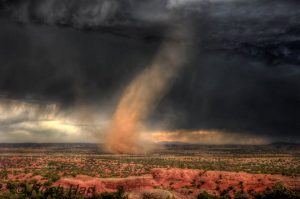 Weather has always been a subject of interest to people, even if we still don’t completely have a full grasp of it, not even after all these years and all our technology. The main difference I see now is that we hear about weather all the time. It’s on television, the radio, and even our phones. There are warnings for everything…thunder storms, tornadoes, snow storms, flash floods, and hurricanes. Nevertheless, all the meteorologists can truly do is predict a weather event. It may or may not materialize.
Weather has always been a subject of interest to people, even if we still don’t completely have a full grasp of it, not even after all these years and all our technology. The main difference I see now is that we hear about weather all the time. It’s on television, the radio, and even our phones. There are warnings for everything…thunder storms, tornadoes, snow storms, flash floods, and hurricanes. Nevertheless, all the meteorologists can truly do is predict a weather event. It may or may not materialize.
Now, flash back to, oh say 1680 or even to 1521. Other than looking at the sky, how did the people predict the weather? Yes the sky can be a great predictor of coming storms, but unless you knew something about weather  patterns, you would be unlikely to have any idea that something like a tornado, flood, or hurricane were coming. Especially in 1680 or 1521. Those dates are rather important in the world of weather. In August of 1521, a meteorological phenomenon occurred in the Basin of Mexico. There were no cameras back them, no cell phones or computers to record the event. The only known description appears in Book XII of the Florentine Codex, which is an account of the Spanish conquest of Mexico written in Nahuatl in the mid-sixteenth century. The account states that just before the fall of Mexico-Tenochtitlan a heavy storm which included a whirlwind struck the basin. The whirlwind hovered for a while above Tlatelolco, Tenochtitlan’s twin city. Then it moved to the lake where it disappeared.
patterns, you would be unlikely to have any idea that something like a tornado, flood, or hurricane were coming. Especially in 1680 or 1521. Those dates are rather important in the world of weather. In August of 1521, a meteorological phenomenon occurred in the Basin of Mexico. There were no cameras back them, no cell phones or computers to record the event. The only known description appears in Book XII of the Florentine Codex, which is an account of the Spanish conquest of Mexico written in Nahuatl in the mid-sixteenth century. The account states that just before the fall of Mexico-Tenochtitlan a heavy storm which included a whirlwind struck the basin. The whirlwind hovered for a while above Tlatelolco, Tenochtitlan’s twin city. Then it moved to the lake where it disappeared.
When the experts of today look at the account of the phenomenon in the context of the Nahua culture, and  comparing it with European descriptions of tornados and waterspouts, they can determine that the phenomenon was indeed a tornado. Their conclusion is further supported by eighteenth and nineteenth century pictorial and written evidence showing that tornadoes do occur in the territory now occupied by Mexico City. Since the tornado of Tlatelolco predates the Cambridge, Massachusetts, tornado of July 8, 1680, which had been thought to be the first recorded tornado in the Americas, the Tlatelolco tornado actually represents the earliest documented tornado in the Americas. Either way, since people didn’t really have much information to go on back then, I’m sure they first said some version of “What is that?!!?” At least, I know I would have.
comparing it with European descriptions of tornados and waterspouts, they can determine that the phenomenon was indeed a tornado. Their conclusion is further supported by eighteenth and nineteenth century pictorial and written evidence showing that tornadoes do occur in the territory now occupied by Mexico City. Since the tornado of Tlatelolco predates the Cambridge, Massachusetts, tornado of July 8, 1680, which had been thought to be the first recorded tornado in the Americas, the Tlatelolco tornado actually represents the earliest documented tornado in the Americas. Either way, since people didn’t really have much information to go on back then, I’m sure they first said some version of “What is that?!!?” At least, I know I would have.

 For most of her life, my sister-in-law, Brenda Schulenberg struggled with her weight. Even as a child, Brenda was heavy. She will tell you that her weight prevented her from doing many of the things that most children took for granted, such as riding a bicycle. She might have been able to do it to a degree, but not for very long or very far. As she grew into adulthood, her weight became such a problem that she couldn’t even think of riding a bicycle. Then one day, her health failed due to her weight. She knew that she had to make a change. That day was October 18, 2013…just 5½ months after her dad, Walt Schulenberg passed away. Brenda became a health nut. She learned to eat right, and she walked…slowly and with a walker at first, and later on her own. She walked further and further…often reaching 10 miles a day. The weight came off, and she felt much better. Still, one thing eluded her…riding a bicycle. Finally, the day arrived when Brenda found out that she could ride a bicycle…as long as the peddles were off, and she could reach the ground. It’s called strider riding. It is a bicycle, but the rider basically runs the bicycle down the trail, instead of riding it…and Brenda could do that.
For most of her life, my sister-in-law, Brenda Schulenberg struggled with her weight. Even as a child, Brenda was heavy. She will tell you that her weight prevented her from doing many of the things that most children took for granted, such as riding a bicycle. She might have been able to do it to a degree, but not for very long or very far. As she grew into adulthood, her weight became such a problem that she couldn’t even think of riding a bicycle. Then one day, her health failed due to her weight. She knew that she had to make a change. That day was October 18, 2013…just 5½ months after her dad, Walt Schulenberg passed away. Brenda became a health nut. She learned to eat right, and she walked…slowly and with a walker at first, and later on her own. She walked further and further…often reaching 10 miles a day. The weight came off, and she felt much better. Still, one thing eluded her…riding a bicycle. Finally, the day arrived when Brenda found out that she could ride a bicycle…as long as the peddles were off, and she could reach the ground. It’s called strider riding. It is a bicycle, but the rider basically runs the bicycle down the trail, instead of riding it…and Brenda could do that. 
After riding strider style for a time, Brenda was finally able to ride a bicycle in the normal way. She put the peddles back on her purple bicycle and off she went. Brenda became just like the postal service…”Neither snow nor rain nor heat nor gloom of night stays these couriers from the swift completion of their appointed rounds.” Ok, Brenda didn’t have appointed rounds…exactly, but she had set herself a goal of riding her bicycle every month of the year. Now, that is not an easy task, especially in the state of Wyoming, where winters can be brutal. Nevertheless, just like the postal worker, neither rain, nor sleet, nor snow, nor gloom of the very early morning will keep Brenda from riding her bicycle. She is determined to ride it, and make up for all the years that she couldn’t even ride a bicycle in the summertime, much less in the winter.
She’s a brave woman, especially when she goes out in the middle of a snow story, and pretty much turns into a 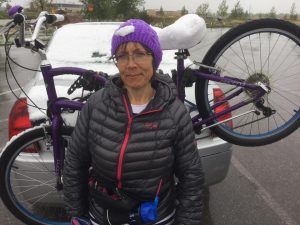
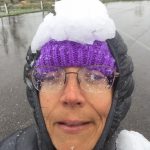 snow woman. She reminds me of the Campbell’s Soup commercial where the little boy is so covered with snow that only a hot bowl of soup will melt away all the snow. Maybe she’s not that bad, but she’s close. Brenda, we are proud of your determination, but I do have to wonder if the people driving by the snow woman on wheels have to rubs their eyes to make sure they are seeing what their eyes are telling them they are seeing. Today is Brenda’s birthday. Happy birthday Brenda!! Have a great day!! We love you!!
snow woman. She reminds me of the Campbell’s Soup commercial where the little boy is so covered with snow that only a hot bowl of soup will melt away all the snow. Maybe she’s not that bad, but she’s close. Brenda, we are proud of your determination, but I do have to wonder if the people driving by the snow woman on wheels have to rubs their eyes to make sure they are seeing what their eyes are telling them they are seeing. Today is Brenda’s birthday. Happy birthday Brenda!! Have a great day!! We love you!!

 My son-in-law, Travis Royce is without a doubt, the most social person in our family. Travis can talk to anyone. There isn’t a shy bone in his body. I think that is one thing that made him such a great DJ when he and my daughter, Amy lived here in Casper. Travis was born in San Diego, and spent a number of years in Puyallup, Washington as a child. He loved it there, and loves the coastal areas in general, so after their children graduated from high school, they made the move to the Seattle area, and now to the Bellingham area. They truly love the area, and I can understand that, because it is quite beautiful there. I don’t know if would love the rain, but they seem to, so it’s all good.
My son-in-law, Travis Royce is without a doubt, the most social person in our family. Travis can talk to anyone. There isn’t a shy bone in his body. I think that is one thing that made him such a great DJ when he and my daughter, Amy lived here in Casper. Travis was born in San Diego, and spent a number of years in Puyallup, Washington as a child. He loved it there, and loves the coastal areas in general, so after their children graduated from high school, they made the move to the Seattle area, and now to the Bellingham area. They truly love the area, and I can understand that, because it is quite beautiful there. I don’t know if would love the rain, but they seem to, so it’s all good.
Travis can make friends wherever he goes, and he loves to entertain…especially with a barbeque. He loves to go all out with the feast he puts on too. He might cook steaks, lobster, or jalapeno poppers…or just burgers. No matter what’s cooking Travis is a good cook, and he is a great host. As I said, he loves to entertain, and he is quick witted, so there is never a dull moment. When Travis is around, there is always a joke going on. Even when my daughter, Amy and Travis aren’t entertaining, they love to sit out in their back yard with a fire going, just enjoying the peace and quiet. Their home is out in the country…or at the edge of town anyway, so it is quiet a quiet neighborhood.
Now you might think that with their love of the country life, quiet would be the order of the day, but that is not always the case. As summer approaches, both Amy and Travis look forward to getting out their motorcycle 
 and cruising the area. With all of the water destinations in their vicinity, they have a lot of pretty drives that they can take. Travis is definitely not a snow lover, so Western Washington is pretty ideal. He wants as many warm months as possible. I can relate to that, but I don’t know that Washington is the ideal place. Still, as Amy says, they don’t like the extreme heat either, so there you have it. All I care about is that Travis loves my girl, and he does. Today is Travis’ birthday. Happy birthday Travis!! Have a great day!! We love you!!
and cruising the area. With all of the water destinations in their vicinity, they have a lot of pretty drives that they can take. Travis is definitely not a snow lover, so Western Washington is pretty ideal. He wants as many warm months as possible. I can relate to that, but I don’t know that Washington is the ideal place. Still, as Amy says, they don’t like the extreme heat either, so there you have it. All I care about is that Travis loves my girl, and he does. Today is Travis’ birthday. Happy birthday Travis!! Have a great day!! We love you!!

 My second cousin twice removed, Hazel Grace Pallas, daughter of Angel and Brian Pallas, is quite a character. I have only met Hazel and her family via Facebook, but her mom and her aunt, Elizabeth Nordquist, have posted a lot of pictures of the kids, and along with the stories they provide, I feel like I’ve known their kids forever. As I said, Hazel is a character, but she is also a Girly Girl, and could even be classed as a Diva, but that isn’t surprising, because she spends a lot of time with her cousins, Addilayde and Meadow Nordquist, daughters of Elizabeth and Aron Nordquist, and they can definitely be Divas.
My second cousin twice removed, Hazel Grace Pallas, daughter of Angel and Brian Pallas, is quite a character. I have only met Hazel and her family via Facebook, but her mom and her aunt, Elizabeth Nordquist, have posted a lot of pictures of the kids, and along with the stories they provide, I feel like I’ve known their kids forever. As I said, Hazel is a character, but she is also a Girly Girl, and could even be classed as a Diva, but that isn’t surprising, because she spends a lot of time with her cousins, Addilayde and Meadow Nordquist, daughters of Elizabeth and Aron Nordquist, and they can definitely be Divas.
While these girls can be girly and artsy, they also love to play, and they have a great time together; as well as with Hazel’s little sister, Tenley; and their cousins, Hosea and Canaan Oltman, sons of Grace and Tzaddik 
 Oltman. It’s so much fun to look at the great pictures of these close families of cousins. The moms take pictures often, especially Elizabeth, who is a photographer in her own right, so I have watched these kids grow up almost all of their lives.
Oltman. It’s so much fun to look at the great pictures of these close families of cousins. The moms take pictures often, especially Elizabeth, who is a photographer in her own right, so I have watched these kids grow up almost all of their lives.
Addi and Meadow, being the oldest ones, inspire all the fun around there. They play with all the kids, and really enjoy having their cousins come over. The other day, the three older girls, Addi, Meadow, and little Hazel were out in the back yard, playing in the snow. For Hazel, who is 2½ years old, I think this is still a very new experience. Nevertheless, it is one she very much enjoyed. The girls got out anything the could slide on, and they had a wonderful time slipping and sliding on the snow. When Hazel told her mom about all she did that afternoon, she simple 
 summed it up as, “Swimming in the snow, Mom!” When I read that comment, I just laughed and laughed. It was perfect. To have that childhood enjoyment of the snow…untainted by the experiences of driving in the snow, and all the stress that comes with it…seemed like a dream world to me. As I was driving to work this morning, with little Hazel on my mind, I noticed that as I drove down the alley from my backyard garage, over the freshly fallen snow, it felt like I was almost floating along. Hazel’s words came to my mind. “Swimming in the snow, Mom!” I think I know how Hazel felt.
summed it up as, “Swimming in the snow, Mom!” When I read that comment, I just laughed and laughed. It was perfect. To have that childhood enjoyment of the snow…untainted by the experiences of driving in the snow, and all the stress that comes with it…seemed like a dream world to me. As I was driving to work this morning, with little Hazel on my mind, I noticed that as I drove down the alley from my backyard garage, over the freshly fallen snow, it felt like I was almost floating along. Hazel’s words came to my mind. “Swimming in the snow, Mom!” I think I know how Hazel felt.
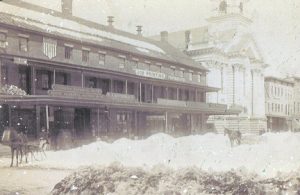 With all of the extreme weather shows, warnings, and education we have access to these days, one would think that blizzard related deaths would quickly become a thing of the past, but it never seems to go that way exactly. Nevertheless, it used to be much worse. In bygone years, the warnings we have today simply didn’t exist, and blizzards were very much feared by the people, and with good reason too. The storms would come up, seemingly without notice, and I suppose that was how it was. People couldn’t turn on their radio, television, computers, or smart phones, and get the weather forecast. They could look at the sky and feel the temperature changing, and maybe guess at what was coming, but if they were wrong, it could be deadly. Such was the case on January 12, 1888, when a blizzard blew into the Northwest Plains region of the United States with little or no warning. Some people said that the temperature dropped 100° in just 24 hours. A lot maybe, but I’ve seen temperature changes of more than 60°, so it’s possible.
With all of the extreme weather shows, warnings, and education we have access to these days, one would think that blizzard related deaths would quickly become a thing of the past, but it never seems to go that way exactly. Nevertheless, it used to be much worse. In bygone years, the warnings we have today simply didn’t exist, and blizzards were very much feared by the people, and with good reason too. The storms would come up, seemingly without notice, and I suppose that was how it was. People couldn’t turn on their radio, television, computers, or smart phones, and get the weather forecast. They could look at the sky and feel the temperature changing, and maybe guess at what was coming, but if they were wrong, it could be deadly. Such was the case on January 12, 1888, when a blizzard blew into the Northwest Plains region of the United States with little or no warning. Some people said that the temperature dropped 100° in just 24 hours. A lot maybe, but I’ve seen temperature changes of more than 60°, so it’s possible.
It was a Thursday afternoon and the weather had been unseasonably warm the previous day from Montana, east to the Dakotas, and south to Texas. Within a matter of hours, the Artic front blew in, plunging the temperature to 40° below zero in much of North Dakota. The freezing temperatures were joined by high winds and heavy snow. It was lethal combination that created a blinding blizzard, just when the children were on their 

 way home from school. The storm, coupled with the time of day, set the stage for a disaster, and unfortunately it would take the lives of 235 people…mostly children making their way home from school in rural areas and adults working on large farms. Both of these groups of people were taken by surprise, and were unable to find their way to their destinations.
way home from school. The storm, coupled with the time of day, set the stage for a disaster, and unfortunately it would take the lives of 235 people…mostly children making their way home from school in rural areas and adults working on large farms. Both of these groups of people were taken by surprise, and were unable to find their way to their destinations.
Some areas decided to err on the side of caution, and that resulted in lives saved. Schoolteacher, Seymour Dopp in Pawnee City, Nebraska, kept his 17 students at school when the storm began at 2 pm. They stayed overnight, burning stockpiled wood to keep warm. The next day, parents made their way over five foot snow drifts to rescue their children. I’m sure they were wondering if they would ever see their children again, because they couldn’t call to check on them, after all. Some areas ha drifts over ten feet too. In Great Plains,  South Dakota, two men rescued the children in a schoolhouse by tying a rope from the school to the nearest shelter to lead them to safety. Minnie Freeman, a Nebraska teacher, successfully led her children to shelter after the storm tore the roof off of her one room schoolhouse. Sadly, not all efforts to save the children were successful. Teacher Loie Royce tried to lead three children to the safety of her home, which was less than 90 yards from their school in Plainfield, Nebraska. They all became lost. The children died of hypothermia, and Royce lost her feet to frostbite. The January 12th storm was dubbed the Schoolchildren’s Blizzard, because most of the 235 victims were children. It is considered one of the worst blizzards in the history of the area, to this day.
South Dakota, two men rescued the children in a schoolhouse by tying a rope from the school to the nearest shelter to lead them to safety. Minnie Freeman, a Nebraska teacher, successfully led her children to shelter after the storm tore the roof off of her one room schoolhouse. Sadly, not all efforts to save the children were successful. Teacher Loie Royce tried to lead three children to the safety of her home, which was less than 90 yards from their school in Plainfield, Nebraska. They all became lost. The children died of hypothermia, and Royce lost her feet to frostbite. The January 12th storm was dubbed the Schoolchildren’s Blizzard, because most of the 235 victims were children. It is considered one of the worst blizzards in the history of the area, to this day.

 When most people think of Hawaii, they think of a tropical paradise, but for my husband, Bob’s uncle, Butch Schulenberg nothing could be further from the truth…at least not during his days in the service. When we think of Hawaii, snow does not come to mind, but in reality, “It snows here every year, but only at the very summits of our 3 tallest volcanoes (Mauna Loa, Mauna Kea and Haleakala),” says Ken Rubin, geology and geophysics professor at the University of Hawaii. “The snow level almost never gets below 9,000 feet in Hawaii during the winter, but since these mountains are taller than 13,000 feet, 13,000 feet, and 10,000 feet, respectively, they get dusted with snow a few times a year. It rarely stays on the ground for more than a few days though.”
When most people think of Hawaii, they think of a tropical paradise, but for my husband, Bob’s uncle, Butch Schulenberg nothing could be further from the truth…at least not during his days in the service. When we think of Hawaii, snow does not come to mind, but in reality, “It snows here every year, but only at the very summits of our 3 tallest volcanoes (Mauna Loa, Mauna Kea and Haleakala),” says Ken Rubin, geology and geophysics professor at the University of Hawaii. “The snow level almost never gets below 9,000 feet in Hawaii during the winter, but since these mountains are taller than 13,000 feet, 13,000 feet, and 10,000 feet, respectively, they get dusted with snow a few times a year. It rarely stays on the ground for more than a few days though.”
I had no idea, as I’m sure many of you could also say. I don’t know if Butch knew what he was getting into when he and the officer he was driving for, went to one of those areas where there was not only snow, but it was cold…really cold. In fact, the only way that Butch could even begin to stay warm was to bundle up in his sleeping bag. He probably would have tied it all the way over his head, if he could breathe that way. It was a complete shock to his system, as it would have been to mine. Being stationed in Hawaii would be the dream assignment, and here Butch was…in the snow. In fact, I can just hear him telling his parents, “It’s freezing here!!” The thought is almost laughable, or would have been if it weren’t so cold.
Butch told my husband, Bob and me several stories about his driving days in the service, when we were there for a visit about a month ago. It was interesting to listen to the details that a driver would have known about 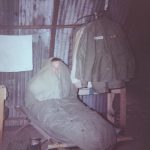
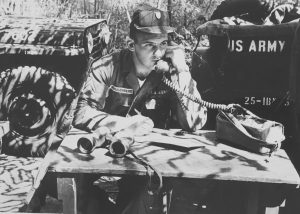 the situations that the company would have been in…and probably a lot of responsibility too. Much of the details of the movements of the company and the battles they engaged in, were classified, and to say anything at the time could have put people in danger or get them killed. A good driver would have known when to talk and when to keep quiet. Butch was a good driver, and well respected. I am proud of his service. Thank you Butch. Today is Butch’s birthday. Happy birthday Butch!! Have a great day!! We love you!!
the situations that the company would have been in…and probably a lot of responsibility too. Much of the details of the movements of the company and the battles they engaged in, were classified, and to say anything at the time could have put people in danger or get them killed. A good driver would have known when to talk and when to keep quiet. Butch was a good driver, and well respected. I am proud of his service. Thank you Butch. Today is Butch’s birthday. Happy birthday Butch!! Have a great day!! We love you!!
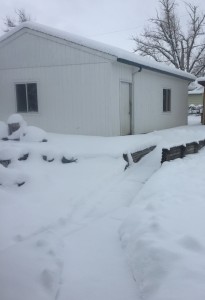 There is an old saying, “If March comes in like a lion, it will go out like a lamb.” If that’s the case, then one must assume that the opposite is also true. And in the case of March, 2016…the opposite would definitely be the case. Bob and I were married on March first, and so we go to Thermopolis around that time to celebrate our anniversary. This year was absolutely beautiful!! It was warm with no snow, and our quiet little walks were just lovely. The groundhog had predicted an early Spring this year…and unusual prediction for him, so I was feeling very optimistic about the remainder of the Winter…or the lack thereof. Now it’s not that I’m superstitious, and I don’t believe that these predictions are superstition anyway, but rather God’s way of showing us little signs of His plans for the future. He tells the animals things that humans just don’t hear, like telling the geese when to fly south or to head north. We humans have somehow become so scientific that we fail to listen to the signs from God.
There is an old saying, “If March comes in like a lion, it will go out like a lamb.” If that’s the case, then one must assume that the opposite is also true. And in the case of March, 2016…the opposite would definitely be the case. Bob and I were married on March first, and so we go to Thermopolis around that time to celebrate our anniversary. This year was absolutely beautiful!! It was warm with no snow, and our quiet little walks were just lovely. The groundhog had predicted an early Spring this year…and unusual prediction for him, so I was feeling very optimistic about the remainder of the Winter…or the lack thereof. Now it’s not that I’m superstitious, and I don’t believe that these predictions are superstition anyway, but rather God’s way of showing us little signs of His plans for the future. He tells the animals things that humans just don’t hear, like telling the geese when to fly south or to head north. We humans have somehow become so scientific that we fail to listen to the signs from God.
Of course, the scientists would say that they are able to predict the weather too, and perhaps they do listen to the signs of God, whether they admit that is what they are doing or not. Still, I find it odd that things like the groundhog not seeing his shadow on February 2nd, or the way March makes it’s annual entrance, can have such an impact of the weather over the next month or so, but they do nevertheless. One thing that many of us have come to look for is the time when the geese fly south. If they head out early, we have a pretty good idea that Winter will soon follow, but if the stay around into late fall, things could be very different for the Winter. They simply have been told that there is no hurry to leave. It is maybe the one sign from God that we humans have noticed over the years.
Be that as it may, we have arrived at the end of March in Wyoming. Enter Winter Storm Troy!! This Winter has been a relatively easy one, even though, the snow that fell in mid-December, didn’t leave the streets until mid-February. Nevertheless, I am pretty much over Winter after the first snow of the season, so I was looking forward to an early Spring. Now, with the end of March upon us, it decides to follow the old saying, and go out 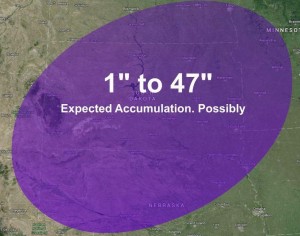 like a lion…since it came in like a lamb. That said, we are sitting here in Wyoming with about sixteen inches of snow on the ground, many businesses closed, and schools that would be…were it not for Spring Break. This storm is not supposed to hang around very long, but those unfortunate people in its path could get anywhere from 1″ to 47″ of the white stuff. I certainly hope we are not on the 47″ end of that scale. The snow is expected to continue through tonight and finally heading out around 6pm tomorrow. After that, look out, because when the temperatures heat up to the low fifties by Sunday, all this snow is going to melt, and become…a whole lot of water. I guess that is the April Fools Day joke in all of this weather prediction process.
like a lion…since it came in like a lamb. That said, we are sitting here in Wyoming with about sixteen inches of snow on the ground, many businesses closed, and schools that would be…were it not for Spring Break. This storm is not supposed to hang around very long, but those unfortunate people in its path could get anywhere from 1″ to 47″ of the white stuff. I certainly hope we are not on the 47″ end of that scale. The snow is expected to continue through tonight and finally heading out around 6pm tomorrow. After that, look out, because when the temperatures heat up to the low fifties by Sunday, all this snow is going to melt, and become…a whole lot of water. I guess that is the April Fools Day joke in all of this weather prediction process.
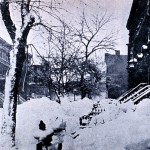 As we sit here, with an early Spring upon us, I find it an odd thing to think about another year that had been rather balmy too. The year was 1888, and things were about to get serious along the northern East Coast. The day began with rain, but as the storm really came at around midnight, the rain turned to snow, and the area began to become a nightmare right before the very eyes of the people in the area. Snowfalls of between 20 to 60 inches were seen in parts of New Jersey, New York, Massachusetts, and Connecticut. The winds howled…sustained winds of more than 45 miles per hour producing snowdrifts in excess of 50 feet. The area railroads were shut down and people were confined to their houses for up to a week. The difficult thing here is that people didn’t have some of the weather predictors that we have these days, so many of them had no idea what was coming their way, and so had far k=less time to prepare for it.
As we sit here, with an early Spring upon us, I find it an odd thing to think about another year that had been rather balmy too. The year was 1888, and things were about to get serious along the northern East Coast. The day began with rain, but as the storm really came at around midnight, the rain turned to snow, and the area began to become a nightmare right before the very eyes of the people in the area. Snowfalls of between 20 to 60 inches were seen in parts of New Jersey, New York, Massachusetts, and Connecticut. The winds howled…sustained winds of more than 45 miles per hour producing snowdrifts in excess of 50 feet. The area railroads were shut down and people were confined to their houses for up to a week. The difficult thing here is that people didn’t have some of the weather predictors that we have these days, so many of them had no idea what was coming their way, and so had far k=less time to prepare for it.
Areas of northern Vermont received from 20 inches to 30 inches in this storm, with drifts reported from 30 to 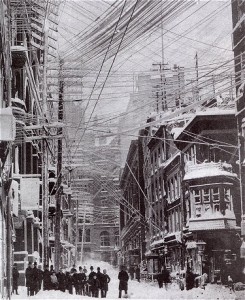 40 feet over the tops of houses from New York to New England. There were also reports of drifts covering 3 story houses. The highest drift…52 feet was recorded in Gravesend, New York. A total of 58 inches of snow fell in Saratoga Springs, New York; 48 inches in Albany, New York; 45 inches of snow in New Haven, Connecticut; and 22 inches of snow in New York City. With the snow came severe winds, with gusts up to 80 miles per hour, although the highest official report in New York City was 40 miles per hour, with a 54 miles per hour gust reported at Block Island. Central Park Observatory, in New York City, reported a low temperature of 6 °F, and a high temperature of 9 °F on March 13…the coldest ever for March. These days Winter Storms have names, but they didn’t then. Nevertheless, the storm was named the Great White Hurricane. It paralyzed the East Coast from the Chesapeake Bay to Maine, as well as the Atlantic provinces of Canada. The Telegraph was disabled because of all the downed lines, isolating Montreal and most of the large northeastern United States cities from Washington DC to Boston for days. Following the storm, New York began placing its telegraph and telephone lines underground to prevent destruction. From Chesapeake Bay through the New England area, more than 200 ships were either grounded or wrecked, killing at least 100 seamen.
40 feet over the tops of houses from New York to New England. There were also reports of drifts covering 3 story houses. The highest drift…52 feet was recorded in Gravesend, New York. A total of 58 inches of snow fell in Saratoga Springs, New York; 48 inches in Albany, New York; 45 inches of snow in New Haven, Connecticut; and 22 inches of snow in New York City. With the snow came severe winds, with gusts up to 80 miles per hour, although the highest official report in New York City was 40 miles per hour, with a 54 miles per hour gust reported at Block Island. Central Park Observatory, in New York City, reported a low temperature of 6 °F, and a high temperature of 9 °F on March 13…the coldest ever for March. These days Winter Storms have names, but they didn’t then. Nevertheless, the storm was named the Great White Hurricane. It paralyzed the East Coast from the Chesapeake Bay to Maine, as well as the Atlantic provinces of Canada. The Telegraph was disabled because of all the downed lines, isolating Montreal and most of the large northeastern United States cities from Washington DC to Boston for days. Following the storm, New York began placing its telegraph and telephone lines underground to prevent destruction. From Chesapeake Bay through the New England area, more than 200 ships were either grounded or wrecked, killing at least 100 seamen.
In New York, all transportation was at a standstill for days, and drifts across the New York–New Haven rail line at Westport, Connecticut took eight days to clear. Partly because of the transportation gridlock, it was decided that they needed a better system, and the first underground subway system in the United States, opened nine years later in 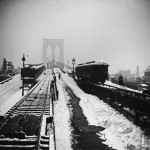 Boston. The New York Stock Exchange was closed for two days…something that almost never happens. Firefighters were unable to get to the fires, and property loss just from the fires was estimated at $25 million. Severe flooding occurred after the storm due to melting snow, especially in the Brooklyn area, which was more susceptible to serious flooding. Efforts were made to push the snow into the Atlantic Ocean. More than 400 people died from the storm and the cold that came with it, including 200 in New York City alone. Among them was former United States Senator Roscoe Conkling. The blizzard also resulted in the founding of the Christman Bird and Wildlife Sanctuary located near Delanson, Schenectady County, New York, which was listed on the National Register of Historic Places in 1970.
Boston. The New York Stock Exchange was closed for two days…something that almost never happens. Firefighters were unable to get to the fires, and property loss just from the fires was estimated at $25 million. Severe flooding occurred after the storm due to melting snow, especially in the Brooklyn area, which was more susceptible to serious flooding. Efforts were made to push the snow into the Atlantic Ocean. More than 400 people died from the storm and the cold that came with it, including 200 in New York City alone. Among them was former United States Senator Roscoe Conkling. The blizzard also resulted in the founding of the Christman Bird and Wildlife Sanctuary located near Delanson, Schenectady County, New York, which was listed on the National Register of Historic Places in 1970.
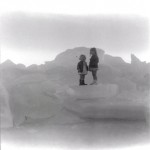
 Every year, I dread the beginning of winter. It doesn’t matter how late it starts, I still wish it was over the minute it begins. I know that many people would say, why do you live where you do, and to that I say…it is where I have always lived…or at least since I was three years old. Before that, up until I was three years old, I lived in Superior, Wisconsin, and I must say that the weather there would have been worse than the winters here, so I have moved to a better place…sort of. Don’t get me wrong…I love Wyoming. It is my home, and in the fall, spring, and summer, I am perfectly happy here. I would just love to eliminate winter all together. I can’t say that I always felt that way about winter, because as a kid, I probably didn’t. I think our parents had no trouble getting my sisters and me to go outside and make snowmen, or snow angels, or build a fort and have a snowball fight. It’s what kids do. In reality it seems like winter bothers us more and more, the older we get. Even my sister, Cheryl Masterson, who loves winter, really has no true desire to be out in it. She likes the beauty of it and the coolness of the air, but shoveling snow or driving in snow…not so much.
Every year, I dread the beginning of winter. It doesn’t matter how late it starts, I still wish it was over the minute it begins. I know that many people would say, why do you live where you do, and to that I say…it is where I have always lived…or at least since I was three years old. Before that, up until I was three years old, I lived in Superior, Wisconsin, and I must say that the weather there would have been worse than the winters here, so I have moved to a better place…sort of. Don’t get me wrong…I love Wyoming. It is my home, and in the fall, spring, and summer, I am perfectly happy here. I would just love to eliminate winter all together. I can’t say that I always felt that way about winter, because as a kid, I probably didn’t. I think our parents had no trouble getting my sisters and me to go outside and make snowmen, or snow angels, or build a fort and have a snowball fight. It’s what kids do. In reality it seems like winter bothers us more and more, the older we get. Even my sister, Cheryl Masterson, who loves winter, really has no true desire to be out in it. She likes the beauty of it and the coolness of the air, but shoveling snow or driving in snow…not so much.
I guess it is a good thing that our lives have seasons too, because if they didn’t, I doubt if anyone would ever do those fun things that kids do in winter. If we all felt the way I do about winter right now, I suppose we would move to a different place every six months or so. That, of course is the snowbird stage of life, except that it would be something that happened much more often, and that is what I would be, were it not for my obligations here. For me, there is a love/hate relationship with the changing seasons. When spring rolls around, I will start to feel alive again, just like the flowers, trees, and birds. My heart sings as the warmer weather approaches, and I feel like hibernating during the colder months. The odd thing too, is that I love winter scenes…in pictures, but in reality, I have no desire to be there…just to look, and then to go out in the warm summer weather I truly love.
Perhaps I need to consider what the difference was when I was a child, and I really did like going out into the snowy weather. Was it that I didn’t mind the cold, or that I didn’t mind dressing for it? Is it that I have 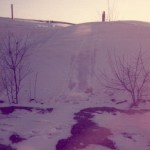
 forgotten how to play? Probably, that is it. In fact the last time I can say that I really played was when my grandchildren were little. I think it would be great if I could travel back in time those 15 or so years to when I would gladly have gone out in the snow with my grandchildren, because…well, I would do just about anything for them. I suppose that even then I can’t say I loved the cold, but I did have a great time playing with those grandchildren…even if it was cold. I can’t go back in time, so here I am at the beginning of another winter. The snow has arrived, the cold is here…and so it begins.
forgotten how to play? Probably, that is it. In fact the last time I can say that I really played was when my grandchildren were little. I think it would be great if I could travel back in time those 15 or so years to when I would gladly have gone out in the snow with my grandchildren, because…well, I would do just about anything for them. I suppose that even then I can’t say I loved the cold, but I did have a great time playing with those grandchildren…even if it was cold. I can’t go back in time, so here I am at the beginning of another winter. The snow has arrived, the cold is here…and so it begins.
 When we think of hurricanes, we think of the ocean, but on November 7, 1913, there was a storm over the Great Lakes that would go down in United States history as the largest inland maritime disaster, in terms of number of ships lost. The storm was nicknamed the White Hurricane. The storm system brought blizzard conditions to areas all around the Great Lakes, with hurricane force winds. The nature of the storm was unique and powerful, and caught even the most seasoned captain by surprise. Two low pressure centers merged and rapidly intensified over the Lake Huron, with periods of storm-force winds occurring over a four day period. Surrounding ports signaled it was a level-four storm, but for some vessels, it was already too late. Major ship wrecks took place on all the Great Lakes except for Lake Ontario. Vessels at that time could withstand 90 mile per hour winds and 35 foot waves, but it was the whiteout conditions and accumulation of ice on the ships that turned an already dangerous situation into a deadly one. Ship captains were unable to maintain navigation, resulting in 12 shipwrecks, 19 ships stranded, and an estimated 250 lives lost. On land, 24 inches of snow shut down traffic and communication, causing millions of dollars in damage.
When we think of hurricanes, we think of the ocean, but on November 7, 1913, there was a storm over the Great Lakes that would go down in United States history as the largest inland maritime disaster, in terms of number of ships lost. The storm was nicknamed the White Hurricane. The storm system brought blizzard conditions to areas all around the Great Lakes, with hurricane force winds. The nature of the storm was unique and powerful, and caught even the most seasoned captain by surprise. Two low pressure centers merged and rapidly intensified over the Lake Huron, with periods of storm-force winds occurring over a four day period. Surrounding ports signaled it was a level-four storm, but for some vessels, it was already too late. Major ship wrecks took place on all the Great Lakes except for Lake Ontario. Vessels at that time could withstand 90 mile per hour winds and 35 foot waves, but it was the whiteout conditions and accumulation of ice on the ships that turned an already dangerous situation into a deadly one. Ship captains were unable to maintain navigation, resulting in 12 shipwrecks, 19 ships stranded, and an estimated 250 lives lost. On land, 24 inches of snow shut down traffic and communication, causing millions of dollars in damage.
The storm took place before the time when weather forecasters had the luxury of computer models, the detailed surface and upper air observations, weather satellites, or radar needed to make the most accurate predictions. Had weather forecasters then been able to access modern forecasting equipment, they may have been able to determine the likely development of this type of storm system in advance, as they did with Superstorm Sandy in 2012. As part of the forecast for Sandy forecasters were able to predict storm force winds over the lower Great Lakes five days in advance. The technology and forecast models available to forecasters today led to a more accurate forecast which saved mariners, recreational boaters, and businesses millions, as they were able to make preparations in advance of Sandy’s storm force winds and near 20 foot waves.
One hundred years later, the National Oceanic and Atmospheric Administration, in the Great Lakes is commemorating the Storm of 1913, not only for the pivotal role it played in the history of the Great Lakes, but also for its enduring influence. Modern systems of shipping communication, weather prediction, and storm preparedness have all been fundamentally shaped by the events of November 1913. It’s strange to think that one storm could make such a lasting impact on so many systems, but then it is the need for something better that spurs great inventive minds to invent a solution to a serious problem.
The National Oceanic and Atmospheric Administration plays a major role in protecting maritime relics of the past. Included are many of the ships lost in 1913. They have remained preserved deep below the surface of the Great Lakes. The National Oceanic and Atmospheric Administration’s Thunder Bay National Marine Sanctuary is a 48-square-mile area of protected territory with one of America’s best preserved and nationally significant collections of shipwrecks. Located in northwestern Lake Huron, Thunder Bay is adjacent to one of the most treacherous stretches of water within the Great Lakes system. Unpredictable weather, murky fog banks, sudden gales, and rocky shoals earned the area the name “Shipwreck Alley.” To date, more than 50 shipwrecks have been discovered within the sanctuary including the Isaac M. Scott, a 504 foot steel freighter lost in the storm of 1913.
This storm holds an interest for me, because at that time in history, my grandparents, Allen and Anna Spencer were living in the Great Lakes area. My grandfather was not part of the crew of any ship, and so any effect to them would have come in the form of very deep snow. My Aunt Laura would have been just 16 months old at 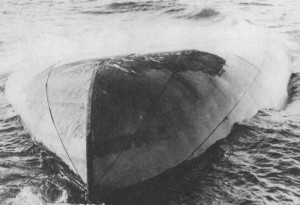 the time. I’m sure that the thought of being stranded in her home, was not a pleasant one for my grandmother, considering Aunt Laura’s very young age, but they survived the White Hurricane, as did most other people, at least those on land anyway. It still seems incredible to me that a storm of that magnitude could have brewed in an inland setting, but then anyone who knows the Great Lakes will tell you that they are so big that they might just as well be considered a sea. The November Gales have long been known as killers, especially over Lake Superior, the largest of the Great Lakes. I’m glad that modern weather forecasting equipment had at least lessened the possibility of ships and lives being lost in the Great Lakes, as well as the oceans.
the time. I’m sure that the thought of being stranded in her home, was not a pleasant one for my grandmother, considering Aunt Laura’s very young age, but they survived the White Hurricane, as did most other people, at least those on land anyway. It still seems incredible to me that a storm of that magnitude could have brewed in an inland setting, but then anyone who knows the Great Lakes will tell you that they are so big that they might just as well be considered a sea. The November Gales have long been known as killers, especially over Lake Superior, the largest of the Great Lakes. I’m glad that modern weather forecasting equipment had at least lessened the possibility of ships and lives being lost in the Great Lakes, as well as the oceans.

